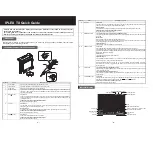
Manual Number: 43331
Manual Revision: B
3500/3600 Series Piezoresistive Shock Accelerometer Operating Guide
1
1.0
Introduction
This Operating Guide contains information that will
familiarize the user with the basic operation and installation of
the
3500/3600
Series
Piezoresistive
(PR)
Shock
Accelerometers. However, it is not intended to cover all of the
specific measurement challenges that one may encounter while
using the device. Therefore, if you have detailed questions or
are unsure of how to properly operate the sensor after reading
this Operating Guide, please contact a PCB Application
Engineer using our 24-Hour SensorLine
TM
at 716-684-0001.
2.0
Principle of Operation
PR accelerometers are passive devices which require stable
external power, typically a regulated dc voltage such as 10V
(or more recently 5V or 3.3V), to operate with new
electronics. These full-bridge sensors include four, active,
silicon strain-sensing elements which change resistance
proportionally to an applied acceleration. In response to an
acceleration input, the resistance will increase for two of the
sensing elements and the resistance will decrease for the other
two elements, as shown in the Wheatstone-bridge circuit of
Figure 1. The sensitivity of the bridge is proportional to the
Excitation Voltage.
Figure 1 – Wheatstone Bridge Circuit
Terminology related to PR devices includes:
ZMO – Zero Measurand Output, also called bias or offset, is
the output when no input acceleration is applied.
TSS – Thermal Sensitivity Shift, the change of sensitivity due
to temperature. The sensors are uncompensated, so they
display a slight linear decrease in sensitivity as temperature
increases.
TZS – Thermal Zero Shift, the change in ZMO due to
temperature. This is less predictable, and from unit to unit may
have positive or negative slope, although it will be stable for
any one unit.
3.0
Features
The 3500/3600 Series uses micro-electromechanical systems
(MEMS) technology, in which all structural and electronic
components are manufactured in silicon using electronic
microfabrication technologies. MEMS devices are preferred in
many high shock impact measurements over piezoelectric
elements, since these PR devices are inherently DC coupled,
exploit the strength of single crystal silicon (SCS) and display
minimal zero shift. However, an additional characteristic of
SCS is extremely low internal damping, which results in
susceptibility to overshoot and resonant excitation. Although
the stiffness of silicon can allow extremely high resonant
frequencies in some MEMS shock sensor designs, PCB
MEMS sensors take a different approach in which the resonant
frequency is intentionally lowered to reduce the response to
higher frequency energy present in shock events. The
relatively low resonance also creates displacements of the
seismic element sufficient to introduce squeeze film damping.
Air is used rather than a fluid so thermal effects on damping
are negligible.
Manufactured using recent advances in semiconductor
processing, the PCB MEMS design consists of a mildly under-
damped sensor with sufficient bandwidth to accurately track
rigid-body vehicle deceleration. Resonant amplification is
reduced by orders of magnitude, and survivability is increased.
Ruggedness is enhanced through the use of mechanical stops.
The sensors are manufactured as the sandwich of three wafers,
with the active core surrounded by the two outer wafers which
provide hermetic protection and restrict the travel of the proof
mass.
Because many such applications are coupled with battery
powered conditioning and data acquisition, PCB MEMS
sensors were designed with relatively high value resistors
(approximately 10 times that of other devices) to maximize
battery life.
4.0
Common Applications
The 3500/3600 Series PR Shock Accelerometers achieve true
DC response for measuring long duration shock. For this
reason, they are preferred for applications in which integration
from acceleration to velocity or displacement may be
or
Yellow
Summary of Contents for 3501A2060KG
Page 10: ......




























